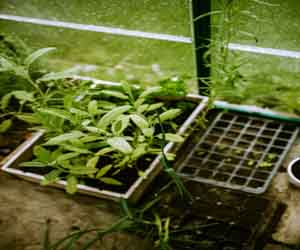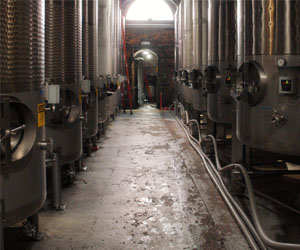


Exploring The Benefits

Herb gardens have been cherished for centuries for their culinary, medicinal, and aesthetic contributions. These vibrant patches of green not only add flavor to your dishes but also offer a multitude of benefits that go beyond their aromatic allure. In this article, we'll delve into the manifold advantages of cultivating your herb garden.
Culinary Delights
One of the most obvious benefits of an herb garden is the immediate access to fresh, flavorful herbs for your culinary creations. Imagine plucking basil, rosemary, or mint straight from your garden to enhance your dishes. This not only adds depth and character to your food but also elevates your cooking to a whole new level of freshness and taste.
Nutritional Value
Herbs are often packed with vitamins, minerals, and antioxidants that can bolster your health. Basil, for instance, is a great source of vitamin K and manganese, while parsley is rich in vitamin C and vitamin K. By incorporating these herbs into your diet, you can enhance the nutritional value of your meals.
Medicinal Properties
Herbs have been used for centuries as natural remedies for a wide range of ailments. Lavender is renowned for its calming and soothing properties, chamomile for its digestive benefits, and peppermint for its ability to alleviate headaches. Growing these herbs allows you to harness their medicinal powers for home remedies and holistic wellness.
Aromatherapy
The fragrant oils found in herbs are not just for flavor and aroma. They also have therapeutic qualities. Lavender, for instance, is widely used in aromatherapy to promote relaxation and reduce stress. Aromatic herbs can transform your garden into an outdoor sanctuary for your senses.
Environmental Benefits
Herb gardens contribute to a more sustainable and eco-friendly lifestyle. By growing your herbs, you reduce the demand for commercially cultivated, chemically treated herbs. This practice conserves resources and minimizes the environmental impact of herb production.
Cost-Effective
Maintaining an herb garden can save you money in the long run. Store-bought herbs can be expensive, and they often come in quantities larger than you need, leading to waste. By growing your herbs, you can have a fresh supply on hand while minimizing expenses.
Educational Value
Herb gardening offers a valuable learning experience. It can be an engaging and educational hobby for individuals and families alike. Gardening teaches responsibility, patience, and an appreciation for the natural world. It allows you to connect with the earth and understand the cycles of growth and renewal.
Aesthetic Pleasure
Herb gardens are not just practical; they are also beautiful. The lush green foliage, colorful blossoms, and fragrant aromas create a visually appealing and soothing garden space. Herbs can be integrated into ornamental garden designs, adding both utility and charm.
The benefits of herb gardens are abundant and diverse, making them a valuable addition to any home. From enhancing your culinary endeavors to contributing to your health and well-being, cultivating herbs can transform your outdoor space into a haven of flavors and aromas. So, whether you have a green thumb or are just starting your gardening journey, consider planting an herb garden and savor the multifaceted rewards it offers.
A Global Celebration Of Brews
 Beer And Celebration: Beer has long been an integral part of celebrations and rituals across the world. In Germany, Oktoberfest is a cultural phenomenon that draws millions of visitors from around the globe. In Ireland, St. Patrick's Day is synonymous with toasts of Guinness and other Irish stouts. In the Czech Republic, beer is often enjoyed during traditional festivals and holidays. Such celebrations highlight the cultural significance of beer and its role in fostering community and camaraderie.
Beer And Celebration: Beer has long been an integral part of celebrations and rituals across the world. In Germany, Oktoberfest is a cultural phenomenon that draws millions of visitors from around the globe. In Ireland, St. Patrick's Day is synonymous with toasts of Guinness and other Irish stouts. In the Czech Republic, beer is often enjoyed during traditional festivals and holidays. Such celebrations highlight the cultural significance of beer and its role in fostering community and camaraderie.
Beer And Food Pairing: Beer culture diversity extends beyond the beverage itself to the world of gastronomy. Beer and food pairing is a practice celebrated in many cultures. The hearty brews of Germany are perfect companions to sausages and pretzels, while the delicate flavors of sushi and sashimi in Japan are enhanced by crisp lagers. In the United States, craft beer enthusiasts have elevated beer and food pairings to an art form, experimenting with intricate combinations that rival wine pairings in complexity and creativity.
Traditional Brewing Techniques: Many regions have preserved their traditional brewing techniques, passed down through generations. For example, the indigenous beer of Africa, known as "sorghum beer" or "umqombothi," is brewed using ancestral methods. Similarly, in South Korea, "makgeolli" continues to be made using time-honored techniques, showcasing the beauty of ancient brewing traditions.


Unwinding Your Senses And Elevating Well-Being
 The Science Of Aromatherapy
The Science Of Aromatherapy
Aromatherapy is a holistic healing practice that uses essential oils, which are extracted from plants, to promote physical and emotional well-being. These essential oils contain natural compounds that have a range of therapeutic benefits. When inhaled, these compounds interact with the olfactory system and the brain, triggering various responses.
Aromatherapy through candles operates on this very principle. As the candle burns and releases the fragrance of the essential oils blended into the wax, these scents enter our respiratory system, affecting our mood, stress levels, and overall health.
Choosing The Right Aromatherapy Candle
The journey into the world of aromatherapy candles begins with selecting the right candle for your needs. Here are a few factors to consider:
Fragrance: The choice of fragrance depends on your goals. Lavender is known for its calming properties, making it perfect for relaxation and sleep. Citrus scents like lemon and orange are invigorating and ideal for boosting energy and focus.
Quality: Ensure that the candle you choose uses high-quality essential oils. The purity of the oils can significantly affect the therapeutic benefits.
Wax Type: Natural waxes like soy and beeswax are often preferred for aromatherapy candles because they burn cleanly and don't produce harmful toxins.
Finding Serenity In Creativity
 One of the most immediate benefits of crafting for inner peace is stress reduction. Engaging in a creative project allows you to temporarily escape from the whirlwind of everyday life. As you immerse yourself in the craft, your focus shifts away from daily worries, and you experience a calming sense of flow and mindfulness. This mental break can significantly lower stress levels and promote relaxation, which, in turn, leads to a greater sense of well-being.
One of the most immediate benefits of crafting for inner peace is stress reduction. Engaging in a creative project allows you to temporarily escape from the whirlwind of everyday life. As you immerse yourself in the craft, your focus shifts away from daily worries, and you experience a calming sense of flow and mindfulness. This mental break can significantly lower stress levels and promote relaxation, which, in turn, leads to a greater sense of well-being.
Crafting is also a practice of mindfulness. When you're deeply absorbed in a creative project, you enter a meditative state where you lose track of time and are entirely present in the moment. This quality of focus and presence can be profoundly calming and is akin to the practice of mindfulness meditation, which is known to reduce anxiety and improve mental health.
Moreover, crafting for inner peace enhances your sense of accomplishment. Watching your project take shape and witnessing your creative vision come to life is incredibly rewarding. This feeling of achievement can boost your self-esteem, instill a sense of pride, and cultivate an inner sense of worth and purpose.
The sense of serenity and peace that crafting brings is deeply rooted in the tactile nature of the activity. Engaging your senses - touching, feeling, and manipulating materials - is a grounding experience. Whether you're sculpting with clay, stitching fabrics, or painting with brushes, the tactile aspect of crafting can connect you with your surroundings and enhance your appreciation for the present moment.
Beauty From The Earth, For The Earth
 Nature's Bounty: Natural cosmetics are crafted from botanical and organic ingredients such as plant extracts, essential oils, and minerals. These clean ingredients nourish the skin, providing a safer and more holistic approach to beauty.
Nature's Bounty: Natural cosmetics are crafted from botanical and organic ingredients such as plant extracts, essential oils, and minerals. These clean ingredients nourish the skin, providing a safer and more holistic approach to beauty.
Clean Formulations: Natural cosmetics are free from harsh chemicals, synthetic fragrances, and toxic additives commonly found in conventional cosmetics. They prioritize the use of clean, safe, and non-toxic ingredients, reducing the risk of skin irritations, allergies, and long-term health concerns.
Environmental Consciousness: Many natural cosmetics brands embrace sustainable and eco-friendly practices. They focus on sourcing ingredients responsibly and use recyclable or biodegradable packaging, significantly reducing their environmental impact.
No Animal Testing: A significant portion of natural cosmetics is cruelty-free, meaning they don't test their products on animals. This aligns with the principles of ethical consumerism and compassionate treatment of animals.
A Journey Through Innovation And Diversity
 Diverse Terroirs: One of the remarkable features of New-World wines is the wide range of terroirs they encompass. New-World wine regions can be found across the globe, from the high-altitude vineyards of Argentina to the cool-climate wine regions of Oregon. This diversity allows for the cultivation of various grape varieties, each suited to specific terroirs. As a result, New-World wines offer an array of flavors and styles that cater to a broad spectrum of preferences.
Diverse Terroirs: One of the remarkable features of New-World wines is the wide range of terroirs they encompass. New-World wine regions can be found across the globe, from the high-altitude vineyards of Argentina to the cool-climate wine regions of Oregon. This diversity allows for the cultivation of various grape varieties, each suited to specific terroirs. As a result, New-World wines offer an array of flavors and styles that cater to a broad spectrum of preferences.
New Grape Varieties: New-World winemakers have been open to experimenting with grape varieties from around the world, introducing lesser-known grapes into their vineyards. For example, in the United States, you'll find varieties like Zinfandel and Petite Sirah, which are less common in European regions. This willingness to diversify grape varieties has led to the discovery of new and exciting flavor profiles, expanding the options available to wine enthusiasts.
Emphasis On Approachability: New-World wines are often celebrated for their approachability. While Old-World wines can sometimes come across as complex and reserved, New-World wines tend to be more fruit-forward, making them accessible to a wider audience. This approachability has contributed to the global popularity of New-World wines.
Innovative Aging Techniques: Many New-World winemakers have embraced modern aging techniques, such as the use of oak barrels from different regions, new oak versus old oak, and a range of toasting levels. These practices have helped create wines with distinctive characteristics, pushing the boundaries of traditional winemaking.
Sustainability And Environmental Practices: New-World wine regions have also been at the forefront of sustainable and eco-friendly winemaking practices.





